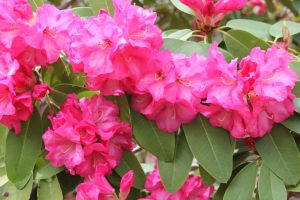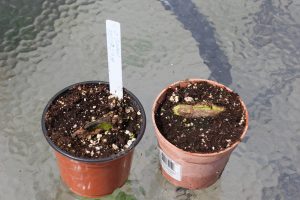You can use your greenhouse not just for growing existing plants but also for obtaining a great many new ones, all for free. One way to do this is by propagation using cuttings. Another way is by harvesting seeds. Here’s more on each of these methods.
First, let’s look at growing plants from cuttings. In late summer, you can take green cuttings from any number of different plants and fairly easily propagate them. For example, I recently took cuttings from a variety of hydrangea bushes, mostly belonging to friends. After leaving only three leaves on each 4-to-6-inch-long cutting, I moistened the stems, dipped them in rooting hormone powder, and planted them in a tray of potting soil, sand, and perlite. I used a pencil to poke holes in the potting mixture into which the cuttings were set, firming the soil around them. If you simply push the cuttings into the mixture, you may inadvertently remove much of the rooting hormone powder. I then placed the tray in the shade of a workbench and gently watered the cuttings daily. Within two weeks, they began to sprout new roots, after which I placed each in a separate, larger pot and left them all to grow. By next spring, these cuttings will be large enough to plant outdoors.

Rhododendrons can also be propagated from cuttings. The most reliable way to get a new plant is to cut halfway through a low hanging twig, sprinkle a little hormone powder on the half-cut and bury it. When the cut portion is rooted, simply cut the new plant from the mother plant and plant it elsewhere.
But you can also increase your stock by taking cuttings. The best time to take the cuttings is during July or August when new growth is beginning to harden off. However, don’t use hard, brown material for cuttings. Instead, find fresh, only slightly hardened new growth. After snipping the cuttings off, remove all but three leaves. Very large leaves might be cut in half to prevent too much transpiration. Then dip each cutting in rooting hormone powder and plant as described for hydrangea, again placing the tray in a shady spot and keeping the cuttings moist but not overwatered. It should not be long before roots develop. This same technique can be used to propagate azaleas, boxwood, blueberries, figs, lemons, limes, and many other bushes and trees.
A second method of obtaining free plants is to harvest their seeds. I don’t mean the seeds you buy in a packet, but rather seeds that you collect yourself. When trying to grow new plants in this way, first make sure that the seeds you’re collecting are not from a hybrid plant. Seeds from hybrids will usually revert to one of the parent plants, or they may even produce something unexpectedly strange.

Although many fruits can be grown from seeds you’ve harvested yourself, plants with large seeds, such as mangos and avocados, are particularly popular to grow in this way. Because it should grow true to type and has very tasty fruit, I’m cultivating Ataulfo (champagne) mangos from seed. The process is simple. After eating the fruit, let the seed pod dry for several days before very gently cutting it open to remove the seed inside. Then plant the seed in moist potting soil and set it in a warm place, although not in direct sunlight. Within two or three weeks, it will start to develop a root and later a stem. Continue to keep the plant moist and warm, never letting the surrounding temperature fall below 45o F. Keep potting the plant up as it slowly grows to four or five feet tall. This process may take four or five years, so be patient. After quite a few years, I have yet to get fruit from my seed-grown Ataulfo mangos, which I’m very much hoping turn out true to this delicious type.


